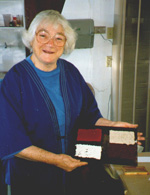Resurgence of Natural Dyes
in the Cusco Region of Peru
By Cindy Gimbert
In Part I, read about how today's weavers are bringing back ancient Andean natural dyes to create vibrant textiles. In Part II, join the weavers of Chinchero in a festive community dye day in this photo journal written by a novice Boston dyer.
Part I: Bringing Back Natural Dyes
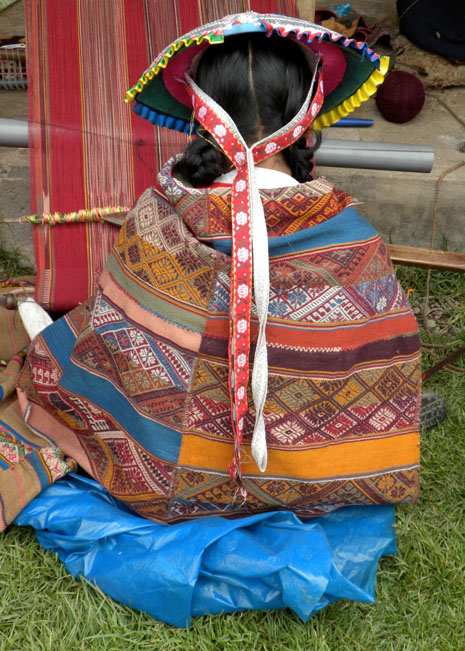
Walking through the markets near Cusco, Peru, your eyes are drawn to piles of brightly colored aniline dyed acrylic yarn. Bright orange, pink and yellow acrylic hand knit caps adorn babies' heads. Where are the beautiful colors of natural dyes and the subtle textures of natural fibers once found in this area? Nilda Callañaupa, in her book Weaving in the Peruvian Highlands (2007), laments that "after commercial chemical dyes became available, dyeing handspun yarn with natural materials disappeared from the Cusco region for almost a hundred years."
Yet today, in the villages of Chinchero, Accha Alta, and Pitumarca, men, women and children proudly wear clothing made of naturally dyed, handspun, handwoven alpaca and wool fiber. Rich, earthy reds, purples, greens and gold again suffuse the fibers. You are surrounded by colors reminiscent of hues achieved by the Inca and even older Peruvian civilizations (Wouters, 1992). (For an introduction to dye plants used in Peru in ancient times, see Kay Antúnez's 1989 article in Economic Botany.) After a hiatus of nearly a century, natural dyeing is alive and thriving in Cusco communities.
| Spinning in Accha Alta, Peru |
Naturally Dyed Alpaca and Wool Weaving Woven by Eugenia Quispe Cjuiro Chinchero-Cusco-Peru 2010 |
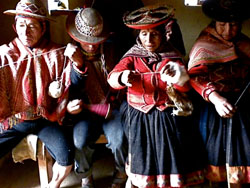 |
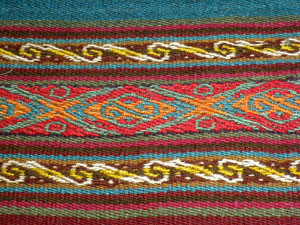 |
| Photograph Copyright by Cindy Gimbert | Photograph Copyright by Cindy Gimbert |
Nilda's Role in the Resurgence of Natural Dyes in the Cusco Region
One woman, Nilda Callañaupa Alvarez, has played a large role in the resurgence of natural dyes in the region. She recalls her early life in an autobiographical essay, "An Endless Thread," in her book Weaving in the Peruvian Highlands. She grew up in Chinchero in the 1960s. When she was only four years old, she went to the fields with her mother. By the time she was six years old she tended a flock of sheep by herself. She became friends with an elderly woman, Doña Sebastiana, whose fine spinning inspired her. During the day on the hillsides watching her flock, she had many hours to spin. At night, she dreamed of spinning. When she entered adolescence, an American anthropologist named Ed Franquemont settled in Chinchero with his family to study Quechua-speaking weavers. Nilda was "one of the shepherd girls who taught [Ed and his wife their] first patterns" (Franquemont, E., no date). Nilda's studies took her to university in the city. Thus began a lifetime of work and scholarship. After graduating from university, she lived for a time in Berkeley, California. Many doors opened to this intelligent, engaging young woman.
"In the end," Nilda realized, "it was weaving that held my life together." (Callañaupa Alvarez, 2007) With the help of her many friends and supporters, she founded the Center for Traditional Textiles of Cusco (CTTC), with a shop selling high quality naturally dyed textiles, a museum, and a dorm where village weavers stay when they work or study at the Center. The center supports weaving communities in nine villages, has built local weaving centers in each village, and sponsors workshops and mentoring. Today Nilda continues to learn from the elders of the community and to teach the youth and larger world the art of traditional Andean textile making.
One of the skills that Nilda has kept alive and passed on to younger generations is that of natural dyeing. In 1998, after experimenting with and studying natural dyes, she began teaching in the Chinchero community. Natural dye recipes and techniques gathered from older community members were passed on (CTTC, 2005). Today the Chinchero weaving community that forms part of Nilda's non-profit Center for Traditional Textiles of Cusco, dyes its own handspun alpaca and wool and offers workshops to other local communities of weavers and to visiting textile enthusiasts.
Part II
Dyeing with the Weavers of Chinchero:
A Photo Journal
The morning rain stopped and the sun shone through the clouds. The snow-covered summits of Chicón and Wequey Willca were still obscured. We had just descended from the weaving community of Accha Alta at 13,000 feet. The valley of Chinchero spread out below us. I could easily imagine why the Inca had developed this beautiful valley as an agricultural center.
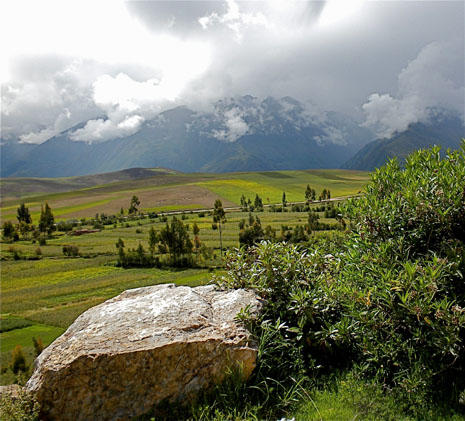
Today was one of the the last days of a two week trip exploring archaeological ruins on the northern coast of Peru and visiting weaving villages in the Cusco region. Cynthia LeCount-Samake, author of Andean Folk Knitting, had organized the tour for a small group of fiber enthusiasts. Our teacher and guide in the weaving communities was none other than Nilda Callañaupa Alvarez, founder and director of the Center for Traditional Textiles of Cusco (CTTC) and author of Weaving in the Peruvian Highlands.
Nilda, a native of Chinchero, asked the driver to pull over. "To the right of that rock, do you see the bush?" she said. "Those are the mountainside flowers we use for a green dye. We call them Chillca in Quechua."
| Chillca flowers used as a green dye | ||
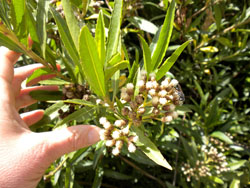 |
||
| Photograph Copyright by Cindy Gimbert |
This afternoon we would be dyeing alpaca yarn with the weavers of Chinchero. But first Nilda had invited us to eat a traditional lunch at her sister-in-law's home, right across from the Chinchero CTTC weaving center. Spread on the table, was a delicious feast which included aji de tarwi (lupine mash), mustard greens, quinoa, chuño (potatoes freeze-dried in high altitude fields), roasted wheat, and cuy (guinea pig). The lupine mash was reminiscent of hummus, but it takes much longer to prepare. You must boil the beans and soak them in the river for two weeks. The rushing river water washes out the noxious bitterness. The first rinse water after boiling is so toxic that it is used to kill potato worm in the fields. Like hummus, the protein and fat content of tarwi is high. Lupine seeds, quinoa, guinea pig and potatoes have been nutritious staples of the Andean diet since Pre-Columbian times.
After the warm hospitality of Nilda's family, we crossed the road and entered the courtyard of the weaving center. The area was abuzz with women laughing, talking, weaving, spinning and knitting.
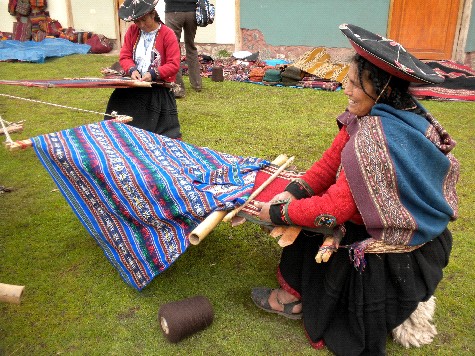
| Knitting a fine gauge chullo (Andean ear flap cap) | Weaving ñawi awapa, the "eye border", on a finished lliclla/manta (shawl) |
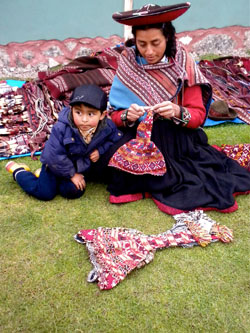 |
 |
| Photograph Copyright by Cindy Gimbert | Photograph Copyright by Cindy Gimbert |
In the back courtyard, women were gathering to start the fires and fill five black cauldrons with water. The dyeing day was a festive occasion. Women wore bright red jobones (jackets) made of plain weave and decorated with buttons and embroidery. Their black polleras (skirts) sported red golones (tapestry bands) at the hem. Each had brought her own handspun to dye. We visitors had brought skeins of store-bought alpaca yarn.
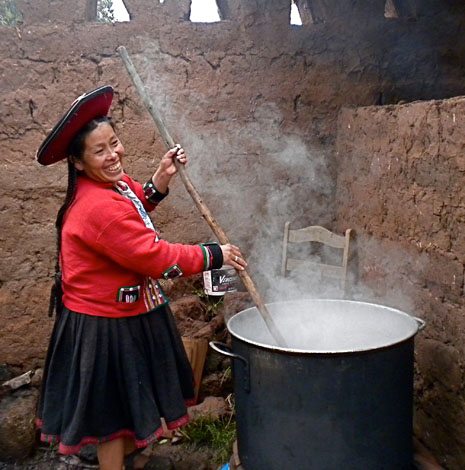
Samples of the dyestuff were laid out: flowers from a bush called Qolle to make a golden yellow; copper sulfate from above Accha Alta to add to the flowers to make green; shapy, a vine from the jungle just over the mountain beyond Accha Alta, for pink; cochineal, the insect which feeds on cactus, for purple; and citric acid and alum to bump the cochineal dye solution to red. Next to the dyestuff were sample skeins of the colors attained by the weavers on a recent dye day.
| Samples of the dyestuff | Sample skeins of the dye colors |
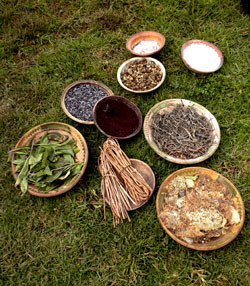 |
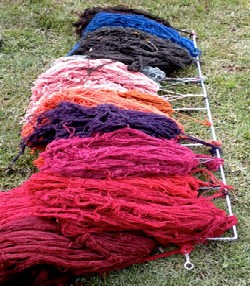 |
| Photograph Copyright by Cindy Gimbert | Photograph Copyright by Cindy Gimbert |
First, we added the yellow flowers to the dye pot. Each of the women threw her skeins into the pot. A weaver stirred the pot vigorously with the long wooden pole, lifting the skeins to check the color, surprisingly heavy work. Then the skeins were pressed firmly down under the water, not a gentle process. Later, flowers, sticks and other plant matter were picked out of the yarn by hand after dyeing.
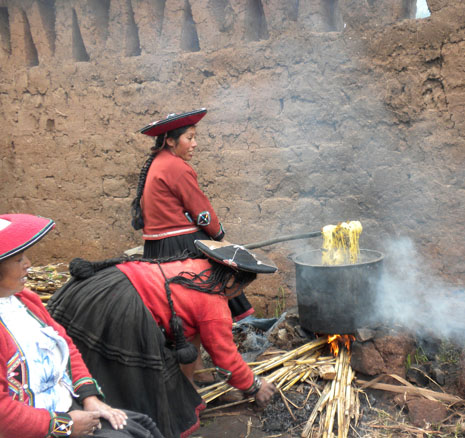
After scooping some liquid from the yellow dye pot into a white plastic pail, Nilda mixed in the copper sulfate from Accha Alta. We then added that solution to a new dye cauldron to create a medium olive.
| Nilda (right) helping stir the dye pot | Removing the medium olive-dyed yarn from the pot |
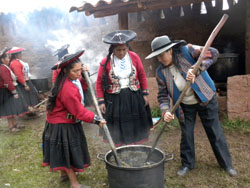 |
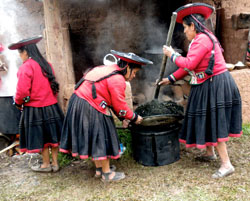 |
| Photograph Copyright by Cindy Gimbert | Photograph Copyright by Cindy Gimbert |
Meanwhile, a group of women had brightened the cochineal dye pot with citric acid and alum. They checked how the color was developing. There was a flurry of activity when Nilda brought out the dyestuff for the pink vat. A group quickly gathered to pull apart the dried vines. Later a check on the vat showed the pastel pink developing.
|
Checking the color of cochineal-dyed yarn |
Pink-dyed yarn entangled with pieces of the dye vine |
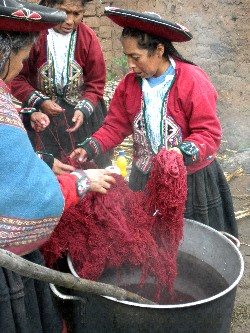 |
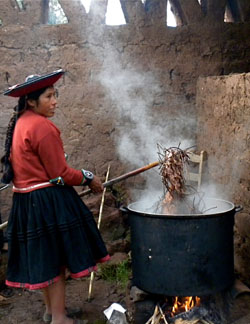 |
| Photograph Copyright by Cindy Gimbert | Photograph Copyright by Cindy Gimbert |
Looking at the mass of tangled sticks and yarn that was pulled out of the vat, I envisioned a frustrating, laborious task ahead. To my surprise, the process of cleaning the yarn went quickly. A group of women talked and laughed as their fingers deftly pulled out vegetable matter from the sticky alpaca. Later they untangled and rewound skeins just as quickly.
At the end of the day, we each took home a kilo of vibrantly dyed alpaca yarn.
Postscript
I would like to thank Nilda Callañaupa Alvarez and Cynthia LeCount Samake for making it possible for me to join the March 2010 community dye day in Peru. Thanks as well to all the spinners, weavers and knitters, who so graciously shared their knowledge with us and welcomed us into their communities. You are keeping the traditional techniques alive with the beautifully vibrant fine textiles you create.
If you are interested in dyeing with the Chinchero weavers, check out the following websites:
For more information on Chinchero textiles, read Nilda Callañaupa Alvarez's book, Weaving in the Peruvian Highlands: Dreaming Patterns, Weaving Memories (2007), Center for Traditional Textiles of Cusco.
• Center for Traditional Textiles of Cusco (www.textilescusco.org/eng/index.html)
• Behind the Scenes Adventures (www.btsadventures.com/EasterintheAndes2011.htm)
• Tinkuy for Tejedores (andeantextilearts.org/tinkuy.htm)
A Few Dyes Used Now in the Cusco RegionMuseum of the Center for Traditional Textiles
of Cusco
|
Kiko (flowers) Bidens andicola Yellows |
Cochinilla/Cochineal (insects) Dactylopus coccus Reds & purples |
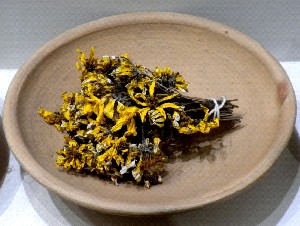 |
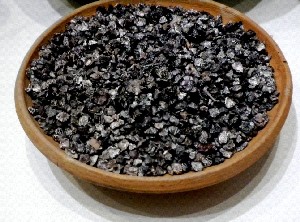 |
| Photograph Copyright by Cindy Gimbert | Photograph Copyright by Cindy Gimbert |
|
Qaqa Sunka ("beard lichen") Usnea barbata Dark blues |
Qolli or Q'olle (flowers) Buddleja coriacea Yellows and oranges |
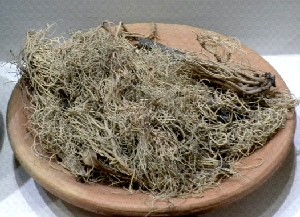 |
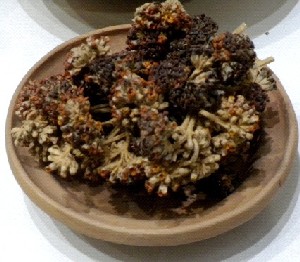 |
| Photograph Copyright by Cindy Gimbert | Photograph Copyright by Cindy Gimbert |
Indigo Research
Research on dyes continues at CTTC. Indira Abarca Lezama leads an indigo dye project. Previously, Andean dyers used processed indigo made from the plant Indigofera tinctoria, which did not grow in Cusco as of 2007. During the period indigo was not available in the area, Chinchero dyers sometimes sent their yarn out to other villages to be dyed. (Callañaupa Alvarez, 2007). Some weavers in the region now buy processed indigo (anil) in the markets when they can find it and dye their own skeins (Threads for Peru, 2010).
Recently, the Center has experimented with growing different types of indigo in the Cusco region. When a weaver from the Boston area heard Nilda's center was trying to grow its own indigo, she sent Japanese indigo seeds, Polyganum tinctorium. CTTC community members planted the seeds in villages at different altitudes. The first harvests are in and Indira has results from the first dye batches. The colors from the initial harvests of Polyganum tinctorium yielded the pastel colors in the photos. Dyes from the new plants have not yet produced the vibrant colors achieved from the Indigo suffruticosa available in the region, but the project continues, as villagers experiment with growing different types of indigo to use in their handspun yarns. Producing dyestuffs locally is one more step in CTTC's efforts to strengthen the living tradition of natural dyes in the Cusco region.
Natural Dyeing Continues to Spread
CTTC's work is also catalyzing a resurgence of natural dyes in a larger area. CTTC's exquisite 100% naturally dyed weavings are sought out by textile collectors and command a good price. Seeing this, weavers in other communities are seeking out the dyeing traditions of their communities and experimenting with natural dyes. Not-for-profit NGOs (non-governmental organizations) have sprung up to educate the larger world to the value of Andean natural dyes and to provide more lucrative international markets for the dyers (See, for example, Threads of Peru, 2010). Nilda and CTTC continue to work as a guiding force in this ongoing resurgence, through workshops, mentoring, and forms of support for indigenous dyers and weavers. (See andeantextilearts.org/tinkuy.htm.) With the heightened interest and resurgence of traditional techniques, the rich tradition of natural dyeing in the Andes is thriving. Natural dyes once again form a vibrant part of the living Andean culture and identity.
Bibliography
Antúnez de Mayolo, K.K. 1989. Peruvian Natural Dye Plants. Economic Botany. 43(2): 181-191. Page 189.
Callañaupa Alvarez, Nilda. 2007. Weaving in the Peruvian Highlands: Dreaming Patterns, Weaving Memories. Center for Traditional Textiles of Cusco. Cusco, Peru.
Centro de Textiles Tradicionales del Cusco. 2005. "Weaving Lives: Traditional Textiles of Cusco, Preserving the Textile Tradition. CTTC. Cusco, Peru.
Franquemont, Ed, Cloth: The Andean Art, Traditional Andean Knitting, AWASQA, workshop handout, no date.
Threads for Peru, How Textiles are Made: Natural Dyes, accessed 9/2010. www.threadsofperu.com/how-textiles-are-made/natural-dyes/
Wouters, Jan and Rosario-Chirinos, Noemi, 1992. Dye Analysis of Pre-Columbian Peruvian Textiles with High-Performance Liquid Chromatography and Diode-Array Detection, Journal of the American Institute for Conservation, Vol. 31, Number2, Article 7, pp. 237-255. cool.conservation-us.org/jaic/articles/jaic31-02-007.html
 Turkey Red Journal
Turkey Red Journal
